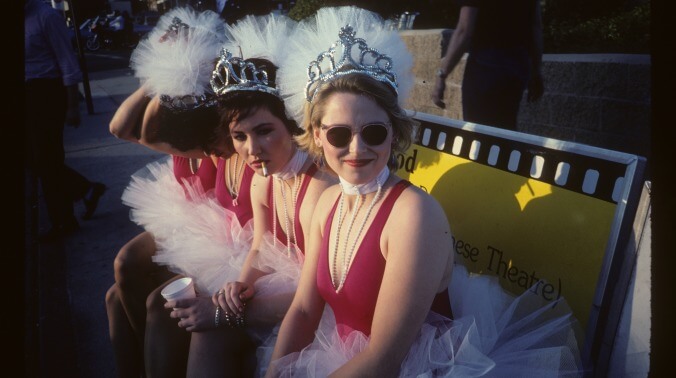The Go-Go’s documentary reveals the dark side of the band’s sunny pop


In the early ’80s, The Go-Go’s were the epitome of bright, breezy fun-girl pop, cresting the first wave of MTV stardom. But the true story of the band is much darker, awash in depression, drug addiction, and intra-band squabbles that belied the group’s candy-colored façade. Documentarian Alison Ellwood continues her encyclopedic efforts to chronicle the California music scene (following History Of The Eagles and Laurel Canyon) with a new Showtime documentary on the first all-girl band in the U.S. to have a No. 1 record playing its own instruments and writing its own songs. As one member of the band says in the movie’s intro, “People automatically assume that we were put together by some guy, but we did it all ourselves.”
The story Ellwood puts together is both straightforward and familiar, traveling from the band’s scrappy beginnings to the pitfalls of fame that would inevitably become its undoing. The Go-Go’s got their start in the decidedly un-sunny arena of the L.A. punk scene, finding empowerment in an environment where they were free to express themselves, and it didn’t really matter how well they could play their instruments. “We hated society and our parents, but we supported each other,” guitarist Jane Wiedlin says. While Wiedlin, guitarist Charlotte Caffey, and vocalist Belinda Carlisle were together in the band’s first incarnation, other original players were replaced, like drummer Elissa Bello being rotated out for Gina Schock, a move that the group credits with helping cement a stronger sound. Schock, who clicked better with the band, was insistent that they practice consistently. By 1980, The Go-Go’s nabbed a brief tour in England opening for ska bands Madness and The Specials, which, while grueling, helped them refine their stage presence.
Candid photos and vintage footage help Ellwood paint the gritty picture of the band’s early years (when its “set was three songs long, and two were the same song,” says one follower), effectively crafting the leap from Whisky A Go Go house band to arena rock stars. Even though the English tour didn’t go so well overseas, the band was greeted with open arms upon its return to the States, based on the strength of early single “We Got The Beat.” The Go-Go’s then traded their more punk-minded bass player, Margot Olavarria, who disapproved of the poppier path the band’s sound was taking, for Kathy Valentine, who says here, “I basically learned all their songs on a coke binge.”
The misogyny of the music industry is portrayed in The Go-Go’s as an almost insurmountable hurdle for the band to conquer. Despite its devoted following and radio-ready sound, the band’s then-manager, Ginger Canzoneri, recalls one label rejection after another due to the then-novelty of an all-girl rock band. Meanwhile, Ellwood uses colorful animation to help explain the genesis of hits like “Our Lips Are Sealed” (which Wiedlin wrote based on a love letter from Terry Hall, her then-boyfriend from The Specials). All five Go-Go’s relay their memories about the band’s early years, as do I.R.S. label head Miles Copeland, who eventually signed the band, and his brother, Stewart Copeland, who recalls having The Go-Go’s opening for The Police while their debut record rocketed up the charts (“They created something that exploded on the stage,” he says). Bikini Kill’s Kathleen Hanna remembers the importance of seeing The Go-Go’s live for the first time, five women dominating a rock stage without a guy in sight.
But as the band ascended, Caffey’s heroin addiction worsened (“Charlotte was so out of control at that point that Ozzy Osbourne threw her out of his dressing room. That’s pretty fuckin’ bad,” describes Schock), as did drug and alcohol use by the other Go-Go’s. Conflicts over how much the songwriters were getting paid compared to the other Go-Go’s led to fractures that the young band members couldn’t repair. “We’d say, ‘We’re like sisters,’” says Wiedlin. “Sure, like sisters that stab each other in the back.” Schock agrees: “The fighting and the real drugs happen when we all get money… [It] wrecks everything.” Wiedlin was the first to leave, in 1984 after the release of the band’s third album, Talk Show, and despite Paula Jean Brown coming in as a replacement (she is credited with finally getting Caffey into rehab), the band dissolved soon after.
The indescribable chemistry between Carlisle, Wiedlin, Schock, Caffey, and Valentine is fully on display throughout the doc; there’s a sad moment near the end when they all describe trying to form other bands after the Go-Go’s dissolution, but could never re-create that brash combination of youth, effervescence, and charisma. But in its fairly short time frame, there’s a lot The Go-Go’s glosses over; for example, despite the fact that the five members have reunited in recent years, Valentine and Schock have both filed lawsuits over compensation. While Caffey is remarkably upfront about her heroin addiction, Carlisle is less so about the longtime coke habit she’s discussed at length in the British press and elsewhere.
And while Hanna’s viewpoint is definitely welcome, it would have been great to hear more female musicians describing the effect of the vast Go-Go’s legacy. Just the fact that they had a debut album that went to No. 1 is remarkable, a feat only matched by a handful of artists like Elvis Presley and The Beatles, as MTV’s onetime veejay Martha Quinn points out; that they had the first No. 1 album in the U.S. by an all-female band that played their own instruments and wrote their own songs is historic. So the story of The Go-Go’s is prime fodder for a documentary like this one, even if the stories behind the songs (like their “Lost Weekend” trip to Palm Springs) are likely darker than some fans would have expected. Ellwood’s most valuable views are these more candid, honest looks, as there’s something refreshing about the band coming clean, revealing all its dirty laundry in a no-holds-barred manner. As it turns out, The Go-Go’s pastel-sweet persona was about as real as the water-skiing in the “Vacation” video. Canzoneri describes the band wandering off of the video shoot onto La Brea Boulevard, smoking and hanging out at a bus stop in full costume—no longer polished and poppy, but happily, perfectly themselves.